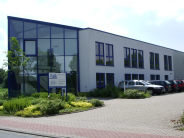Cleaner laundry thanks to full textile supply
Textiles are a matter trust, particularly in the health sector. Being a leading service provider in the sector means offering a professional supply system that completely relieves the customer of complex laundry logistics. The "Simeonsbetriebe" in Minden, known on the market under the name Sitex, concentrate on comprehensive full textile supply – flanked by smooth logistics, custom services and a constant stream of new ideas that make work easier for the customer. |
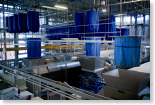 |
The large-scale laundry on the Minden site for the health sector and general professional clothing from the rental market also covers the complete upstream and downstream transport logistics, along with the actual processes of washing, drying, ironing, pressing and folding. To ensure the "supply chain" from the delivery of the dirty laundry to the finished packed items runs smoothly, quickly and reliably, the continuous flow of data must be ensured, particularly at the interfaces between the individual processes and parts of the plant. During expansion work in Minden, the specialists from Falk Steuerungssysteme were commissioned to, among other tasks, design a central article and customer database. The database provides all the key data so that, in combination with an intelligent material store, the efficiency of the operation is significantly increased. Other tasks were to achieve a continuous flow of data throughout the system, to provide remote maintenance features, and to realise data display systems. "In principle the task was to realise a wish list tailored to our needs", summarises Dr. Uwe Wiedermann, head of production on the Simeons sites. |
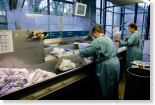 Sorting the dirty laundry by customer and type data |
Flow of laundry
The dirty laundry is delivered by lorry in wire crates, packed in so-called Wickelsacks. To book the laundry into the system the member of staff only needs to enter the related customer and type on the terminal. All other data are added automatically from the database. After further transport to the sorting stands, the data are displayed in the immediate field of view of the staff. The display system defines the box into which the laundry is placed to suit the customer and type data. Laundry batches with optimum load weight are produced by the intelligent control system that evaluates the eight sorting boxes via weighing cells. As a rule the control system opens the duct after 50 kilograms. The laundry batch so produced receives from the system all the key data such as customer number, type of laundry, weight and destination information. A lift then passes the units to the overhead track installed under the roof of the building. |
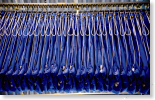 Empty laundry sacks space-savingly "parked" under the building roof |
This gravity powered transport system represents the central supply artery for all areas of the large-scale laundry. Buffer stores are connected to this artery from which the three washing lines are supplied to suit their cycles. "Together with Falk we have realised an intelligent storage strategy with which we can also react very well to fluctuations in deliveries", explains Dr. Wiedermann. The combination of flexible transport system and temporary storage decouples the processes of laundry sorting, washing and finishing. As a consequence surplus capacity or a shortfall in capacity, as well as time for breaks and maintenance can be compensated using the laundry store under the roof. "For all requirements involving high quality, efficient processes increase above all the productivity – and in the end contribute to added value and the success of the business." |
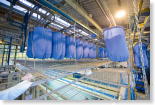 The overhead track system is the central supply artery for all laundry areas |
Setting the points right
For hygiene reasons the laundry building is physically separated into a clean area and a dirty area. Accordingly, the washing lines are loaded in the dirty area and drying using centrifuges or presses takes place in the clean area. The three washing lines in Minden achieve a performance of 2.5 to 3 tonnes an hour. The average performance per week in two-shift operation is around 200 tonnes. And to achieve optimal machine loads particularly at peak times, the systems retrieve from the store the batches that suit the current washing program. For this reason on placing the laundry in the store after the sorting station, the points on the overhead track must be set such that the batches arrive at the store depot in the correct order – without getting in each others way following a call command from the order list for the washing machine. The process data are fed back from the washing lines, a solution from Kannegiesser, by cycle. In this way the status of a batch of washing can also be checked centrally when it is in the "island world of the washing line control system". Falk realised the depiction of the processes on HMIs using colour codes with which the personnel can differentiate between the different types of laundry at a glance. "Today we utilise a very variable form of data display that represents the system states using sequences and that permits quick remote control so-to-speak", the head of production is pleased to state. The control concept also makes it possible to intervene in the sequences in the PLC controllers via the control system so that these can be reset, for instance during maintenance. "Our staff are so familiar with the automation that malfunctions are rectified in a very short time. The same applies to manual operation – for instance manually switching the pneumatic valve for overhead track points." In relation to the continuous flow of data with a central database, Dr. Uwe Wiedermann also places high value on the fact that members of staff can log into the system in real-time via the internal network, or also from off the site via the Internet. "I like using this function myself to check the situation in production. We must know where we are, also in the evening and on days on which we do not normally work." For Dr. Wiedermann the Falk solution therefore represents overall a tool with which the business can be significantly more efficiently controlled. "The system reduces the load on us, and not only in the case of malfunction."
Author Thorsten Sienk is a freelance journalist from
Bodenwerder. |
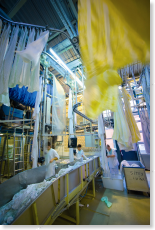 The continuous flow of data increases the productivity in the large-scale laundry in Minden |
